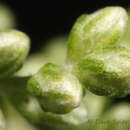Comprehensive Description
(
Inglês
)
fornecido por North American Flora
Artemisia vulgaris L. Sp. PI. 848. 1753
Artemisia indica canadensis Besser; Hook. Fl. Bor. Am. 1: 323. 1833. Absinthium vulgare Dulac, Fl. Hautes-Pyr. 502. 1867.
A stout perennial, with a rootstock; stem 5-15 dm. high, sparingly tomentose when young, striate, often purplish; lower and middle leaves ovate in outline, pinnately or bipinnately divided to near the midrib, green and glabrate above, white-tomentose beneath, 5-10 cm. long; primary divisions 5-7, obovate, oblong or oblanceolate, acute, the ultimate lanceolate, often few-toothed; upper leaves pinnatifid with lanceolate or linear divisions, or those of the inflorescences simple; heads very numerous, at first nodding, soon erect, narrow, in a leafy panicle, with racemose branches; involucre campanulate, about 4 mm. high, 3-4 mm. broad, more or less tomentose; bracts 8-10, in about 3 series; outermost bracts ovate, about half as long as the innermost; inner bracts oblong, obtuse; ray-flowers 6-12; corollas 2 mm. long; disk-flowers 5-15; corollas 2.5 mm. long; achenes 1.5 mm. long.
Type locality: Europe.
Distribution: Newfoundland to Manitoba, Wisconsin, Alabaina, and Georgia; British Columbia; Martinique; escaped from cultivation and naturalized; native of the Old World.
- citação bibliográfica
- Per Axel Rydberg. 1916. (CARDUALES); CARDUACEAE; TAGETEAE, ANTHEMIDEAE. North American flora. vol 34(3). New York Botanical Garden, New York, NY

